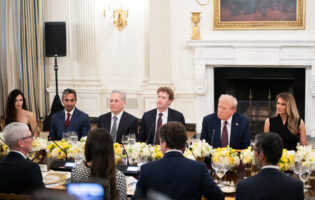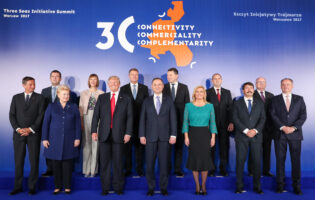
Carol M. Highsmith Archive, Library of Congress via Picryl
Transatlantic Cooperation in the Chip War

Philip Nock
University of Bonn
Philip Nock is a DAAD/AGI Fellow in September and October 2024. He works as a research fellow at the University of Bonn's Center for Advanced Security, Strategic and Integration Studies (CASSIS) and is part of the research group Infrastructures of China’s Modernity. There he is also pursuing his PhD, titled “Awakening to the Era of Weaponized Interdependence? Semiconductor Production Networks, Sino-U.S. Tech Competition, and European Responses,” under the supervision of Prof. Dr. Xuewu Gu and Jun.-Prof. Dr. Maximilian Mayer. He holds an MA in Political Science and a BA in History, Politics, and Society from the University of Bonn.
At AGI, Philip Nock will research semiconductor technology and re-shoring initiatives. During his fellowship, he will develop recommendations for better U.S.-German policy coordination by harnessing the complementary strengths of U.S. and German industry and research (and those of third partners). For this purpose, he will map existing re-shoring initiatives and projects in the United States and Germany planned since 2020, analyze German and U.S. legislation and strategic documents, and conduct expert interviews to identify areas of misalignment.
Enhancing U.S.-German Policy Coordination on Re-shoring Semiconductor Manufacturing
Semiconductor chips have become the basic component of the digital transformation. From smartphones, computers, and cars to jets and drones, nearly every digital device requires semiconductor technology to function. As our daily lives are getting increasingly digitized, the importance of microchips has been rising simultaneously. However, the interplay of production geography, the COVID-19 pandemic, and Sino-U.S. tensions has disrupted global supply chains, creating a severe chip shortage. This crisis forced governments worldwide to reassess their economic policies and work toward reducing technological dependencies. In navigating the intricate landscape of semiconductor production, global supply chain dynamics, and geopolitics, a collaborative approach between the United States and Germany emerges as a strategic imperative. The following essay puts forward five recommendations for Washington and Berlin to improve policy coordination on semiconductor production and thereby achieve greater resilience in what Christopher Miller has called the “Chip War.”[1]
The Chip Shortage: Interdependencies, Supply Chain Dynamics, and Geoeconomics
Beyond the COVID-19 pandemic’s severe impact on individuals, communities, and societies, it also substantially altered contemporary thinking on economic interdependence, as it brought asymmetrical (inter-)dependencies, high production concentration, and supply chain vulnerabilities to the fore. Coupled with external shocks, among them industrial miscalculations such as in the automotive sector, natural disasters, and the effects of the U.S.-China trade war, skyrocketing demand for chips overstrained and disrupted global semiconductor production capacities in the early 2020s. The chip shortage and resulting spill-over effects impacted over 150 sectors and industries throughout the first two years of the pandemic.[2] In 2021, more than ten million fewer vehicles were produced, and the global automotive industry’s losses for that year are estimated to have exceeded $200 billion.[3]
In response, President Biden reflected on how the geography of semiconductor production has changed to his country’s disadvantage: “America invented the semiconductor, but today produces about 10 percent of the world’s supply—and none of the most advanced chips. Instead, we rely on East Asia for 75 percent of global production.” Production is heavily concentrated in East Asia, especially in Taiwan (RoC), South Korea (RoK), China (PRC), Japan, Singapore, and marginally in Malaysia.[4] That the entire semiconductor industry depends on little more than a handful of countries, which increasingly engage in competition with each other, reveals the fragility of these complex and specialized supply chains. Due to the high division of labor, capital and knowledge intensity, long production cycles, transnationality, and strong lock-in effects, the global semiconductor industry is unable to adapt quickly to external demands. Thus, it represents a prime example of the way interdependencies and geoeconomics increasingly pose challenges to both governments and industries.[5] Despite these strong structural constraints, policymakers began to implement strategies to diversify said supply chains and reverse offshore manufacturing. These strategies revolve around ideas to on-, near, or friend-shore semiconductor production. All of this makes a coordinated effort necessary to address semiconductor supply chain issues and the growing role states play here.
The CHIPS and Science Act and the European Chips Act: Re-shoring chip manufacturing?
The transatlantic policy responses to the chip shortage are heavily based on their respective Chips Acts. The U.S. CHIPS and Science Act from 2022 consists of $53 billion in government funding and nearly $400 billion in additional industry funding. About three-quarters of public CHIPS funding ($39 billion) is dedicated to fab construction. The remaining funding ($14 billion) is being spent on fostering a more robust domestic ecosystem for semiconductor production, including research and development and workforce cultivation. Total investments will be based on CHIPS, state, local and private sector funding. Generally, the investments in semiconductor manufacturing are concentrated in states with existing industry. The largest investments go to Arizona, California, New York, Ohio, and Texas. As the mapping indicates, there is not much evidence to substantiate any claims of political favoritism toward red, blue or swing states, as all of them are represented.[6] The graph below illustrates the geographic distribution of investments into semiconductor manufacturing.

Apart from its domestic side, the act also has an international dimension: it prohibits recipients of CHIPS funding for ten years from expanding semiconductor manufacturing in China and other countries of concern. Furthermore, it mandates transparency toward the U.S. government regarding persons, entities, and countries of concern. Moreover, the Biden administration convinced the Netherlands and Japan to further restrict technology exports (such as latest lithography systems) to China in 2023.[7]
Meanwhile, the European Chips Act from 2023 is the central instrument for German and European ambitions to double EU-based production shares to one-fifth of the global market by 2030. For this purpose, the European Commission committed to mobilize more than €43 billion of public and private investments and set measures to prepare, anticipate, and swiftly respond to any future supply chain disruptions. The legislation builds on three action pillars:
- The “Chips for Europe Initiative” to support large-scale technological capacity building and innovation;
- An EU framework to incentivize public and private investments in manufacturing facilities;
- A coordination mechanism through the European Semiconductor Board (between the Commission, Member States, and stakeholders).
The Scholz government closely aligns itself with the European Chips Act and the Commission’s goal to create a state-of-the-art European chip ecosystem. In the EU, the German and Dutch semiconductor sectors are most centrally involved in global semiconductor production networks. The German industry is a key supplier of automotive integrated circuits (ICs), chemicals, and optics. Yet the ambitions of the traffic light coalition went beyond that. Linked to the European Chips Act, the Scholz government focused on building and subsidizing manufacturing sites in Germany. This includes projects with Intel in Magdeburg, Infineon (and others) and TSMC in Dresden, and Wolfspeed in Saarland. Notably, the start of construction of the Intel and Wolfspeed sites was delayed by at least two years. This has effectively jeopardized the EU’s goal to double its share of global semiconductor manufacturing by 2030, even before the coalition’s collapse due to a fundamental dissent on the 2025 federal budget.

The mapping revealed fifty-four semiconductor manufacturing projects in the United States. Twenty-four of these are new fabs and twenty-eight concern existing plants, with twenty-two expansions and four modernizations. In Germany, on the other hand, there are eight semiconductor manufacturing projects, among them five new plants and three expansions.[8] When comparing the two Chips Acts, the strategic goals are shared across the Atlantic (based on a shared understanding of risks), the amounts of public investments are roughly the same, and both sides have an openness to cooperate with like-minded countries. Legislative differences exist, however, regarding the competition laws and institutional frameworks. EU competition law requires that subsidies must be directed to “first-of-its-kind” facilities that fall under the exception for promotion of innovation. The United States has no such law in place for federal approval of these subsidies. The U.S. framework is widely regarded as more straightforward (with bilateral grant agreements between the Department of Commerce and individual industry recipients), yet includes requirements that may add complications in process and execution. The EU framework has more layers and players, where applicants have to secure commitments from member state governments first, which in a second step must also be approved by the European Commission. Another difference is the source of the public investments. While the CHIPS & Science Act provides “new money” to invest in the U.S. semiconductor ecosystem, offers tax incentives to the private sector, and builds capacities in the Department of Commerce to administer all of this, the European Chips Act has primarily shuffled funds from previously existing programs.[9] The EU institutions also assign the member states the task of contributing all further investments, provide no such tax incentives to the private sector and lacks HR capacities.[10] Observers have called this vast expansion of public investments in semiconductor manufacturing a “subsidy race” because public funding is much greater than pre-COVID.[11]
Finding a common language? Semiconductor supply chain security in the U.S. and German National Security, Industrial, and China strategies
These re-shoring and supply chain resilience efforts in the semiconductor sector are part of the wider economic security agendas that have emerged in Washington, Brussels, Berlin, and many other capitals. The Biden administration’s National Security Strategy (NSS) calls strategic public investment “the backbone of a strong industrial and innovation base in the 21st century global economy” and states that it is “securing our supply chains, including through new forms of public-private collaboration, and using public procurement in critical markets to stimulate demand for innovation.” This envisions a much more active role of the state, integrating industrial, trade, technology, and foreign policy to fit the insight that economic security is necessary for maintaining national security. In line with the first Trump presidency’s stance, this also indicates a more critical position on globalization and lean supply chains, e.g., with semiconductors, than the preceding administrations pursued. Likewise, the NSS of the Scholz government—a first in the history of the Federal Republic—also reveals a broad understanding of security. Foreign Minister Baerbock even mentions in her foreword the necessity of reliable semiconductor supply chains so that citizens’ smartphones function. In the strategy, the German government emphasizes its recognition of the security risks that economic dependencies in critical areas such as semiconductors and the intensified international technology competition overall pose. Moreover, Berlin pledges in the NSS its commitment to the rules-based international order and ties this to continued access to markets, raw materials, technologies, and financial and human capital. With Germany having benefitted in many ways from globalization, the Scholz government links supporting the existing international order to the country’s economic well-being. This constitutes an important difference to both the Trump and Biden administration.
This linkage between national security and economic policy is also apparent in industrial strategies. “Bidenomics” accepts and largely continues Trumpian goals to safeguard U.S. technology leadership. The difference between the two administrations consists primarily in methods and their approaches to international partnerships. The Biden administration has enacted several large pieces of legislation (e.g., IRA & CHIPS and Science Act) to reverse off-shoring by boosting manufacturing jobs, R&D, and the green transition in the United States, while continuing to impose tariffs on China and adding additional trade screenings and restrictions.
Against the backdrop of the Zeitenwende and how it affects the German economy, the Federal Ministry for Economic Affairs and Climate Action’s (Bundesministerium für Wirtschaft und Klimaschutz, BMWK) industrial policy puts forward new economic priorities. These include pursuing economic security, protecting its domestic industry from unfair competition abroad, and implementing a just transition. Robert Habeck’s BMWK bases this on a holistic Europe-orientation, a strong German and European locations policy, and—a mini-Zeitenwende for the ministry—an active funding policy.[12] With Germany’s long-time successful economic model being increasingly challenged by geopolitical realities, the traffic light coalition’s strategy suggests that industrial policy therefore must adapt or face even greater risks.
The federal government’s China strategy from 2023—also a first in German history—builds on the NSS and outlines its approach to bilateral relations, EU-China policy, and international partnerships in light of a changing China and geopolitical environment. Its central insight is that economic and technological dependencies on China are detrimental to German and European competitiveness, sovereignty, and security and need to be addressed in a whole-of-government approach. Semiconductor technology is highlighted across all three dimensions of the relationship. The design of the European Chips Act as well as increasing semiconductor supply chain security and diversification are key measures for the Scholz government.[13]
The shift from the Biden administration to the Trump administration presents an opportunity as well as the necessity for the German government to demonstrate its economic importance and the value of transatlantic cooperation in addressing the challenges of the Chip War.
Although the Scholz government’s emphasis on climate action and upholding the rules-based international order differs from the Biden administration, these strategies indicate a progressing alignment in terms of language, priorities, and objectives. Yet the Biden administration’s strategies refer much more often to specific technologies and sectors, including the semiconductor industry, whereas the Scholz government stays more general in outlining its policies and goals such as technological and digital sovereignty. With President-elect Donald Trump taking office on January 20, 2025, and early elections in Germany on the horizon for February 2025, both governments are poised to see their waning days. How much of their strategic approaches to semiconductor supply chain security and reshoring chip production will remain under their predecessors is thus an open question. While some high-ranking Republicans, including President-elect Trump and Speaker Mike Johnson, have at various points during the campaign criticized the legislation and its public spending[14], I do anticipate modifications to the CHIPS and Science Act rather than its complete reversal.
Recommendations for Washington and Berlin to enhance policy coordination
Whilst not having exactly the same meaning and mindful of their individual economic structures, interdependencies, and private sector needs, the U.S. and German governments have found a common language on de-risking economic interdependencies with China and their respective economic security agendas. Regardless of who is in government, the U.S.-EU Trade and Technology Council (TTC) holds continued value for transatlantic cooperation as a direct forum to discuss and coordinate economic policy. Still, different assessments of the TTC’s purpose prevail on both sides of the Atlantic. U.S. policymakers tend to view the TTC more as a China-centric economic security platform, while their German and European counterparts take a more general approach to exchange on trade and technology policy and wish to use the TTC to prevent future disputes in these areas from escalating. With new governments in Washington and Berlin and a new European Commission incoming, reorganizing and adapting the TTC to the needs of the second half of the 2020s will be high on the agenda. Europeans should be receptive to such proposals and not just disapprove of them because it comes from the Trump administration. Yet to maintain established lines of communication, information-sharing, the joint early warning mechanism in case of future supply chain disruptions, and overall trade and tech policy coordination, transatlantic decisionmakers should continue this forum.
Both parties should make coordination on outbound investment screenings a priority for 2025. The policy implementation process is taking shape in Brussels, and with only an executive order by President Biden existing in the United States, there is talk in Congress to finally put this into law.[15] For this matter, German input is particularly relevant because German foreign direct investment makes up over half of EU overall direct investments in China and is the largest European trade partner for China. The incoming German government and the Trump administration should harmonize their export restrictions as much as possible to give their respective private sectors planning security, a clear legal framework, and conducive trade conditions. Moreover, Germany and the EU should emulate the U.S. approach and widen its cooperation with the Department of Commerce regarding investing in HR capacity-building. The German government and the Commission must address the lack of human resources in their administrations. They require a sufficient number of officials who only have the semiconductor sector in their portfolio.
Apart from using existing bilateral and multilateral channels, transatlantic coordination could also benefit from engaging in minilateral formats, particularly to strengthen and stimulate sector-specific cooperation with allies and like-minded partners. Minilateralism refers to the idea of bringing “to the table the smallest possible number of countries needed to have the largest possible impact on solving a particular problem.”[16] One example would be to expand the cross-government and sectoral cooperation between Germany and the Netherlands (or by extension the EU) and the “Chip 4 Alliance,” comprising the United States, Japan, South Korea and Taiwan, or a G7+ format (including South Korea and Australia).[17] The shift from the Biden administration to the Trump administration presents an opportunity as well as the necessity for the German government to demonstrate its economic importance and the value of transatlantic cooperation in addressing the challenges of the Chip War.
List of US-based CHIPS-funded semiconductor manufacturing projects

Source: Own Research based on data from the U.S. federal and state governments, national and local news, and the Semiconductor Industry Association.
List of German-based semiconductor manufacturing projects funded by the European Chips Act[18]

Source: Own Research based on data from the European Commission, the German federal and state governments, as well as national and local news.
Acknowledgments: I thank the DAAD and AGI for funding this research, Peter S. Rashish and Elizabeth Hotary for their constructive comments, and Thomas Protzman for his excellent research assistance in compiling this data and mapping the semiconductor manufacturing projects in the United States and Germany.
[1] Christopher Miller, Chip War: The Fight for the World’s Most Critical Technology (New York, NY: Scribner, 2022).
[2] See Toshiya Hari, Kota Yuzawa and Rod Hall, “The Global Chip Shortage: Impact, Outlook and Recovery,” Goldman Sachs Exchanges, June 29, 2021; Daniel Howley, “These 169 industries are being hit by the global chip shortage,” Yahoo Finance, April 25, 2021.
[3] See Stephanie Brinley, “The semiconductor shortage is – mostly – over for the auto industry,” S&P Global Mobility, July 23, 2023; Alexander Ziegler and Eckhard Heidling, “Die Automobilindustrie in der Chip-Krise.
Herausforderungen – Maßnahmen – Gestaltungsfelder,“ München: ISF München, 2023.
[4] Henry Wai-Chung Yeung, Interconnected Worlds. Global Electronics and Production Networks in East Asia (Stanford, CA: Stanford University Press, 2023), pp. 130-131.
[5] See Jan-Peter Kleinhans and Julia Hess, “Understanding the global chip shortages. Why and how the semiconductor value chain was disrupted,” Interface, November 16 2021.
[6] See the appendix for a detailed list of all announced projects. A possible exception to this may be the TSMC plant in Arizona because the lack of water resources indicates that political considerations may have prevailed in that particular decision-making process.
[7] Henry Farrell and Abraham L. Newman, Underground Empire. How America Weaponized the World Economy (Henry Holt and Co.: New York City, 2023), pp. 200-201.
[8] Yet the delays of the Ensdorf and Magdeburg projects puts their funding and thus their continuance at risk.
[9] New money refers here to federal spending newly appropriated by Congress (for the first time), whereas the EU funding stems from previously appropriated spending, which was redirected to the European Chips Act. This has also made it a somewhat controversial move within Brussels and the member states, as the money was redirected from programs like Horizon Europe and Digital Europe, thus resulting in trade-offs with other digital and research objectives. See Shivakumar, Sujai, Charles Wessner, and Thomas Howell, A World of Chips Acts: The Future of U.S.-EU Semiconductor Collaboration, Center for Strategic and International Studies (CSIS), August 20, 2024.
[10] See Jan-Peter Kleinhans, The Missing Strategy in Europe’s Chip Ambitions. Member States Must Drive the Next Steps, Interface, July 30, 2024.
[11] See, David Kamin and Rebecca Kysar, The Perils of the New Industrial Policy: How to Stop a Global Race to the Bottom, Foreign Affairs, 102 (3), (2023), p. 92-103.
[12] The following quote gets to the heart of the strategic approach by the Scholz government: „Economic security means that we, as the EU, do not render ourselves vulnerable and open to blackmail – not that every Member State needs to be able to make everything itself.” Federal Ministry for Economic Affairs and Climate Action (BMWK), Industry policy in changed times: Safeguarding our industrial base, renewing our prosperity, boosting our economic security, Berlin, October 2023.
[13] De-Risking is defined in the Federal government’s China strategy as reducing dependencies in critical areas, considering economic decisions from a geopolitical perspective and increasing our resilience. See Bundesregierung, China-Strategie der Bundesregierung, Berlin, July 2023.
[14] See Dylan Butts, Trump likely to uphold CHIPS Act despite his campaign rhetoric, policy experts say, CNBC, November 21, 2024; Sujai Shivakumar, Charles Wessner, and Thomas Howell, Too Good to Lose: America’s Stake in Intel, Center for Strategic and International Studies (CSIS), November 12, 2024.
[15] See Filip Medunić, The EU and US Outbound Investment Screening: Know the Flows, Internationale Politik Quarterly, September 24, 2024.
[16] Moises Naim, Minilateralism. The magic number to get real international action, Foreign Policy, June 21, 2009; see also Maximilian Mayer and Gedaliah Afterman, Do more clubbing. How forming partnerships can help tech middle powers survive the escalating US-China tech war, Global Policy, EGG commentary series, April 26, 2023.
[17] See Jaemin Lee, The U.S. and its allies want to bring the entire chip supply chain in-house—and that could create an OPEC-style cartel for the digital age, Forbes, March 28, 2024.
[18] This table lists the funding as planned before the delays of the projects in Ensdorf and Magdeburg were announced. Since no federal budget was yet agreed upon for 2025 and the allocated sums for semiconductor manufacturing repurposed, this seems to jeopardize the public funding for the manufacturing sites and hence the two projects. See Christian Rath, Staat ohne Haushalt. Haushalterische Folgen des Koalitionsbruchs, Legal Tribune Online, November 15, 2024.
Supported by the DAAD with funds from the Federal Foreign Office (FF).







